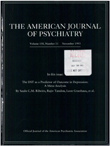Clinical features of cocaine-induced paranoia
Abstract
OBJECTIVE: The authors' objective was to assess the frequency and nature of cocaine-induced paranoia. METHOD: They interviewed 50 cocaine- dependent men consecutively admitted to a 28-day rehabilitation program. RESULTS: Thirty-four (68%) of the 50 men reported highly distressing transient paranoid states in the context of cocaine use. The men who experienced paranoia did not differ from those who did not in age, race, or measures of cocaine use. The mean duration and amount of cocaine use before development of paranoia of the men who reported paranoia were not significantly different from the mean lifetime duration and amount of cocaine used by the men who did not report paranoia. Paranoia became more severe and developed more rapidly with continued cocaine use. CONCLUSIONS: The transient paranoid state appears to be a common feature of cocaine dependence and does not seem to be simply a result of exceeding a threshold of use. Rather, affected individuals might possess a predisposition to this drug-induced state. The fact that paranoia became more severe and developed more rapidly with continued drug use is consistent with a sensitization model of cocaine-induced paranoia. In vulnerable individuals, limbic sensitization may underlie its expression, but localization to a specific brain region is speculative. Quantity of use and route of administration do not appear directly to predispose to this phenomenon. Future investigations must be aimed at uncovering the markers and meaning of vulnerability to transient paranoia in heavy cocaine users.
Access content
To read the fulltext, please use one of the options below to sign in or purchase access.- Personal login
- Institutional Login
- Sign in via OpenAthens
- Register for access
-
Please login/register if you wish to pair your device and check access availability.
Not a subscriber?
PsychiatryOnline subscription options offer access to the DSM-5 library, books, journals, CME, and patient resources. This all-in-one virtual library provides psychiatrists and mental health professionals with key resources for diagnosis, treatment, research, and professional development.
Need more help? PsychiatryOnline Customer Service may be reached by emailing [email protected] or by calling 800-368-5777 (in the U.S.) or 703-907-7322 (outside the U.S.).



